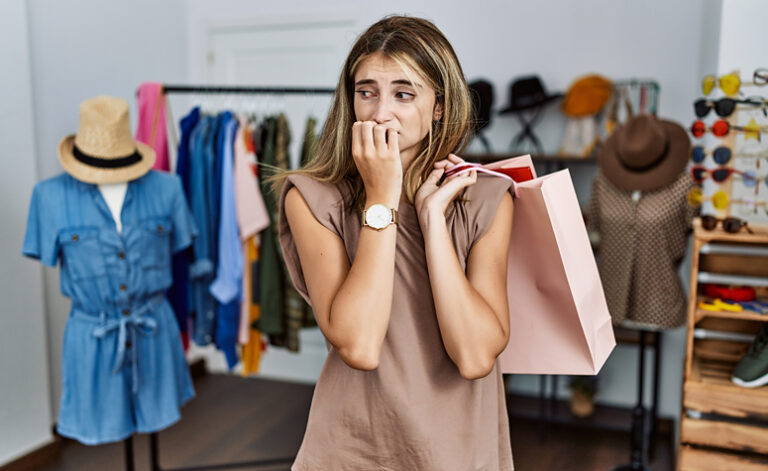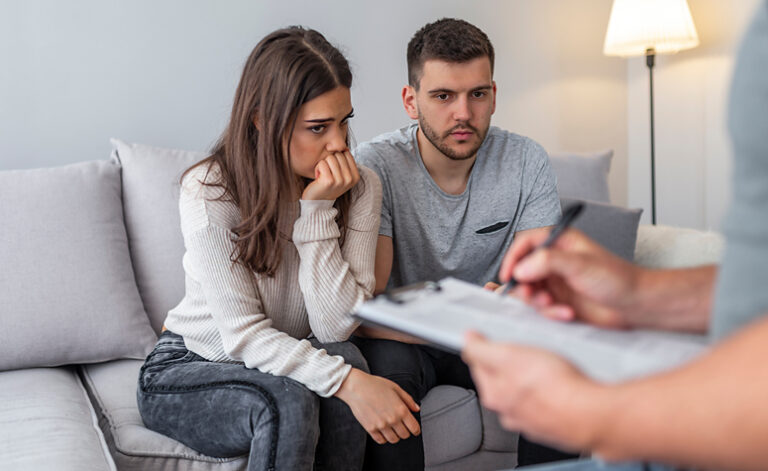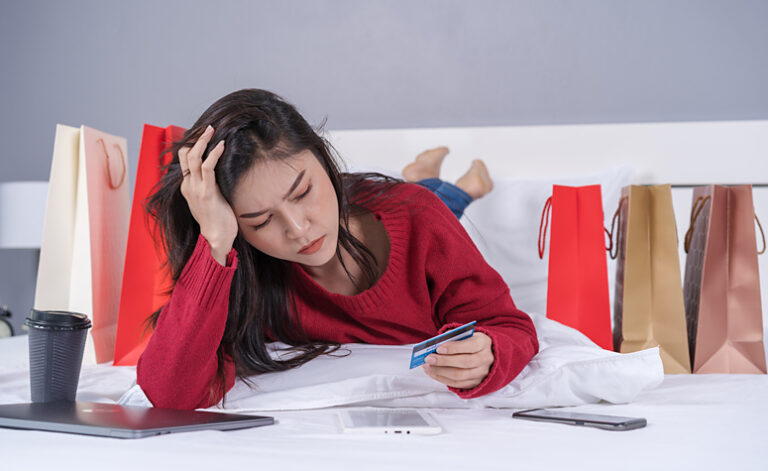Shopping Addiction Treatment
Oniomania, otherwise known as compulsive shopping disorder or shopping addiction, is a serious mental health condition. When left untreated, this disorder can have devastating effects on an individual’s relationships, finances, and general well-being.
At AddictionRehab, we understand the complex nature of this condition, which is why we offer personalised treatments tailored to each individual’s needs in our numerous centres across the UK. Our 28-day Addiction Treatment Programme offers an ideal environment for individuals struggling with shopping addiction to address their struggles head-on.
Essentially, the unique circumstances of your condition will dictate the course of your treatment. Once you start your sessions with our dedicated specialists, they will work on identifying the underlying causes of your compulsive shopping disorder. As a result, they will determine the most suitable course of action for your specific case, including any need for medication.

Understanding Shopping Addiction
Shopping addiction is a compulsive disorder. More specifically, individuals with this condition feel an overwhelming urge to shop excessively and uncontrollably. If left untreated, the individual suffering from this disorder will inevitably enter a pattern of destruction.
Essentially, oniomania can be a seasonal obsession or a chronic condition. It can lead to the same type of behavioural patterns seen in addictions caused by substance abuse. In most cases, shopping addiction is caused by underlying psychological problems. Despite clear similarities to substance abuse and its underlying psychological roots, some do not recognise this disorder as a debilitating disease.
At AddictionRehab, our mental health experts are trained to deal with the root causes of these compulsions and guide you on your path to recovery.

Treatment for Shopping Addiction
According to research, most people suffering from shopping addiction will acknowledge that they have a problem. However, they are unaware of how to seek help for their disorder. Fortunately, we can provide you with access to professional treatment plans, offering a broader understanding of their condition.
As a patient, you will benefit from flexible appointment scheduling and access to experienced medical professionals who will assess your specific case. This includes gaining insight into your shopping habits in order to identify potential underlying psychological issues. From there, they will use a combination of therapy, psychology, and, if needed, medication.
Ultimately, the first step towards receiving effective treatment is to pursue help for shopping addiction. Then, our staff will be able to determine the type and duration of your treatment, tailoring it to your specific needs.
We offer outpatient treatments during which you will need to attend hourly sessions at one of our centres with your assigned consultant, psychiatrist, or therapist. However, severe cases of oniomania may require inpatient treatment.
If this is the case, you will participate in a comprehensive psychological group program. Furthermore, you will also receive regular sessions with your consultant to ensure that you are provided with a focused and highly supportive environment.
Therapy and medication treatment
If excessive shopping is starting to negatively affect your life, therapy, and potentially medication, can offer relief from this compulsive behaviour.
- Cognitive behavioural treatment
Namely, CBT (Cognitive Behavioural Therapy) is incredibly effective for shopping addiction. This is an action-oriented approach that requires patients to work with an assigned therapist to gain a better understanding of the impact oniomania has on their lives and those around them.
As our patient, you will delve into emotions, behaviours, and thoughts driving your compulsion to shop excessively. Additionally, we offer group sessions where you can gain a strong support system from others facing similar challenges.
Overall, the goal of our CBT sessions is to help our patients develop positive coping techniques and learn how to find pleasure in activities that aren’t damaging to their everyday lives or their loved ones.
- Dialectical behaviour therapy
As mentioned, shopping in excess is a form of compulsive behaviour. To that end, DBT (Dialectival Behaviour Therapy) targets the intricate link between the thoughts and actions of an individual during active shopping addiction.
By integrating emotional regulation techniques and mindfulness, this form of therapy is meant to equip patients with the tools necessary for navigating and resisting the compulsion to indulge in excessive shopping.
- Medication
Considering that shopping addiction often coexists with other mental health conditions such as depression and anxiety, it may be necessary for some patients to receive medication in order to alleviate their symptoms. Interestingly, such medication can also have a positive effect on the symptoms of oniomania.
This is most common when excessive shopping manifests as a coping mechanism for the aforementioned mental health conditions. In those cases, anti-anxiety or anti-depression medication may be prescribed.
- 12-Step addiction treatment programme
If patients do not respond to therapy or medication-based treatment, a different approach may be required. Our 12-step addiction treatment programme offers a variable alternative, designed to equip individuals with the necessary tools to live their lives as recovering addicts.
In essence, this programme relies on peer support from individuals facing similar struggles and aids in preventing post-treatment relapse. Through collaboration, our patients tackle the difficulties of managing their compulsive behaviour, and in turn, gain a better understanding of the impact their addiction has on their personal and professional lives.
In order to receive more information regarding the treatment options we offer, feel free to visit our approach to addiction treatment page.

What is Shopping Addiction?
Shopping addiction is a destructive behavioural disorder characterised by a constant struggle to control the urge to shop for goods. This disorder involves a persistent preoccupation with buying items both online and in physical stores, eventually leading to a continuous cycle of emotional highs and lows.
Studies indicate that shopping addiction affects between 8-16% of adults in the UK, which is around 8 million people. It is primarily teens and women in their early twenties who have a tendency to fall into this compulsive behavioural pattern.
Affected individuals often find themselves going through a rollercoaster of emotions. Initially, individuals become overwhelmed with thoughts of shopping, followed by feelings of anxiety before making a purchase. This is succeeded by a brief sense of euphoria, which then gives way to strong feelings of guilt or shame.
As a result, this pattern of behaviour can lead to frequent shopping trips and an overwhelming urge to shop, despite being aware of the potential consequences, which can include financial difficulties, relationship problems, and more.

Fast Access to Residential Treatment
We are currently able to offer fast access to private inpatient treatment.
Please call us today and speak to one of our expert advisors.
Call in confidence: 0800 0148 970
Understanding a Shopping Addiction?
Ultimately, the growth of shopping addiction we’re experiencing can be attributed to the pervasive consumer culture that dominates Western societies. Unfortunately, the constant exposure to television and online advertisements that promote excessive consumption has normalised the notion of shopping beyond necessity.
For most people, shopping is typically perceived as a positive activity and a pleasurable distraction away from work or studies. However, individuals with addictive tendencies develop a compulsion to shop and are driven by the desire to recreate the pleasurable sensations triggered by making a purchase.
Furthermore, societal gender roles contribute to a higher prevalence of shopping addiction among women than men. More often than not, women are expected to fulfill the roles of primary caregivers and homemakers. As a result, they have greater exposure to shopping-related activities such as purchasing household items, clothing for family members, and groceries.
However, it’s important to recognise that, beyond societal influences, excessive shopping is fuelled by the brain’s craving for the release of dopamine. In that sense, oniomania is similar to substance addictions.

Signs and Symptoms of a Shopping Addiction?
Our trained professionals at AddictionRehab offer support in identifying the symptoms of shopping addiction and compulsive spending. Following the fleeting sensations of pleasure and euphoria post-purchase, some long-term symptoms may manifest due to:
- Constant feelings of guilt related to purchases
- Financial difficulties caused by overspending
- Strained relationships with loved ones
More often than not, friends or family members of those suffering from shopping addiction will typically notice the symptoms first. However, in some cases, these signs may be more difficult to detect. To that end, here are additional signs and symptoms of oniomania to be aware of:
- Seeking comfort in shopping (in person or online) in order to cope with negative emotions or stress, resulting in a temporary mood boost that
is similar to euphoria - Concealing shopping habits by either hiding or discarding purchased
items to avoid scrutiny from friends or family - Consistently exceeding a set budget during shopping outings
- Frequently engaging in impulsive shopping sprees driven by a strong compulsion rather than genuine necessity or desire for specific items
- Persisting in shopping despite being aware of the adverse financial implications on themselves or the family
- Struggling to adhere to self-imposed limits on shopping frequency or expenditure, despite several attempts to do so
- Feeling ashamed or guilty about the amount spent and items purchased

The first step towards getting somewhere is to decide
that you are not going to stay where you are
How Tell Whether You Have a Shopping Addiction
or Just Like to go on Shopping Sprees?
For a great number of people, distinguishing between a harmless shopping spree and a chronic addiction to shopping is quite challenging. There are, however, certain distinctions between the two.
- Shopping spree
During a shopping spree, individuals may be inclined to spend more money than planned. This could mean making larger purchases or buying more items than usual during a typical shopping trip. However, it’s important to note that even if you overindulge and spend in excess, you will usually stay within your means. Furthermore, shopping sprees usually occur sporadically, often coinciding with special occasions such as holidays or birthdays. These are moments when treating yourself or purchasing gifts for loved ones is customary. - Shopping addiction
Unlike occasional splurges, shopping addiction occurs as a regular part of a person’s routine, characterised by consistent overspending on various unnecessary items. Typically, those struggling with this addiction often engage in multiple shopping trips in a short timeframe, exhibiting compulsive and excessive purchasing habits. Frequently, they will go through various credit or store cards, building up significant amounts of debt and exacerbating the cycle of addiction.
Dual diagnosis
Similar to other types of dependency, shopping addiction frequently coexists with other psychiatric and mental health conditions. This could potentially form a dual diagnosis alongside shopping addiction:
- Depression
- Obsessive-compulsive disorder (OCD)
- Attention deficit hyperactivity disorder (ADHD)
- Bipolar disorder
- Alcohol addiction
- Gambling addiction
What Causes Shopping Addiction?
Although the specific cause of shopping addiction remains unknown, it’s understood that a mix of biological and environmental elements can influence a person’s susceptibility to addictive behaviour.
Research suggests that approximately 10% to 15% of individuals possess a predisposition towards addiction. This tendency is driven by the brain’s release of pleasure-inducing chemicals like dopamine and endorphins. This predisposition can be triggered by various activities, including shopping, and is further influenced by biological and environmental factors.
Biological factors
Many studies have been conducted on individuals with gambling or sex addictions. Specifically, how they respond to stimuli associated with their addictive behaviours. This research shows that certain actions can elicit brain reactions akin to the changes seen in drug addicts when exposed to substances such as alcohol.
If we extend this understanding to oniomania, it is possible that shopping may provoke a chemical response in the brain. Moreover, this response is similar to the one in individuals with substance abuse issues.
Environmental factors
After taking environmental influences into consideration, experts agree that there is a great possibility that compulsive shopping may serve as a coping mechanism for stress. Specifically, instead of turning to alcohol or drugs, individuals may view excessive shopping as a means of escaping their past trauma.
Ultimately, the detrimental impact that shopping addiction can have on an individual’s life should not be underestimated. Online platforms such as eBay and Amazon present significant temptations to those dealing with oniomania. Due to their expansive product selections and ease of access, users constantly make unnecessary purchases, thus fostering their spending addiction.
FREE Addiction Assessment
If your or a loved one are struggling with addiction, we understand the challenges you’re facing and we’re here to offer compassionate help.
Our highly trained advisers are available to speak to you right away, simply call 0808 252 3379 today.
We can discuss your concerns in complete confidence, explore the options for treatment, and help you to understand what will work best for you.
We’ll also help you to book your free addiction assessment there and then, with appointments usually available within only a few days.
We understand that taking the first step can be the most difficult, but we’re here to support – with no pressure or judgement.
Professional and compassionate help is just a phone call or click away.




